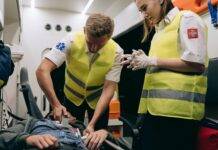
Anaphylaxis Management: First Aid
Anaphylaxis Management : In a world full of potential allergens, understanding anaphylaxis and how to manage it through first aid is crucial. Anaphylaxis is a severe and potentially life-threatening allergic reaction that demands immediate attention. Whether you or someone you know is at risk, knowing how to respond effectively can save lives. In this article, we’ll cover the ins and outs of anaphylaxis management, providing you with a comprehensive guide on administering first aid.
Introduction
Anaphylaxis, a severe allergic reaction that affects multiple systems in the body, requires immediate action to ensure the best chance of survival. This article aims to provide a clear understanding of anaphylaxis, its triggers, signs, and most importantly, how to administer first aid in such a critical situation.
Understanding Anaphylaxis
Anaphylaxis occurs when the immune system overreacts to a substance that it mistakenly identifies as harmful. This triggers the release of chemicals that lead to a sudden drop in blood pressure, narrowed airways, and other severe symptoms.
Common Triggers
Various allergens can cause anaphylactic reactions, including certain foods (peanuts, shellfish), insect stings, medications (penicillin), and latex. Identifying personal triggers is crucial for preventing future episodes.
Recognizing the Signs
Anaphylaxis symptoms can escalate rapidly. Look for signs such as difficulty breathing, swelling of the face and throat, a rapid or weak pulse, and a sharp drop in blood pressure. Skin reactions like hives and pale or flushed skin are also common.
First Aid Measures
Step 1: Call for Help
As soon as you suspect anaphylaxis, call emergency services. Time is of the essence.
Step 2: Administer Epinephrine
Administer an epinephrine injection if available. Epinephrine helps counteract severe symptoms and buys time until medical professionals arrive.
Step 3: Assist Breathing
Help the individual find a comfortable position and encourage slow, deep breaths to ease breathing difficulties.
Step 4: Make Comfortable
Lay the person down and raise their legs to improve blood circulation. Loosen tight clothing and cover them with a blanket to maintain body warmth.
Seeking Medical Attention
Even if the symptoms seem to improve after administering epinephrine, seek medical attention immediately to assess the situation and prevent a potential second wave of symptoms.
Preventive Measures
Avoiding known triggers is paramount. Read food labels, inform restaurant staff about allergies, and carry prescribed medications like antihistamines and epinephrine.
Educational Campaigns
Raising awareness about anaphylaxis within communities, schools, and workplaces can foster empathy, understanding, and preparedness.
Supporting Anaphylactic Individuals
Providing emotional support to those with anaphylaxis can help them cope with the challenges they face. Compassion and knowledge can make a significant difference.
Anaphylaxis Action Plan
Step 1: Allergen Identification
Pinpoint allergens through testing and consultation with medical professionals.
Step 2: Creating a Personalized Plan
Work with healthcare providers to develop a detailed anaphylaxis action plan.
Step 3: Sharing the Plan
Disseminate the plan to caregivers, schools, workplaces, and anyone in regular contact with the affected person.
Training for Caregivers
Empower caregivers, teachers, and friends with knowledge about anaphylaxis management and the proper use of epinephrine auto-injectors.
Dispelling Myths
Clearing up misconceptions about anaphylaxis can help combat stigmas and encourage timely action.
Building Allergy-Aware Communities
Promote understanding and inclusivity in communities by encouraging open conversations about allergies and anaphylaxis.
Emergency Preparedness
Familiarize yourself with the steps outlined in this article and be prepared to act swiftly in case of an anaphylactic emergency.
Conclusion
Anaphylaxis can be frightening, but with the right knowledge and preparation, you can make a significant impact on someone’s life. By understanding anaphylaxis, its triggers, and the steps to administer first aid, you become a valuable link in the chain of survival.
Cardiopulmonary Resuscitation (CPR): A Lifesaving Technique
Emergency Medical Kit: First Aid
Bleeding Control: A Guide to Managing and Responding to Bleeding Incidents
FAQs
- What causes anaphylaxis? Anaphylaxis is typically triggered by allergens, such as certain foods, insect stings, and medications.
- Can anaphylaxis be prevented? While it can’t always be prevented, knowing your triggers and taking precautions significantly reduces the risk.
- How fast does epinephrine work during anaphylaxis? Epinephrine acts quickly, often providing relief within minutes, but seeking medical help afterward is still vital.
- Can anaphylaxis occur on the first exposure to an allergen? Yes, anaphylaxis can occur on the first exposure, although subsequent exposures usually trigger faster and more severe reactions.
- What should I do if I suspect someone is experiencing anaphylaxis? Call for emergency assistance, administer epinephrine if available, help with breathing, and keep the person comfortable while awaiting help.





















